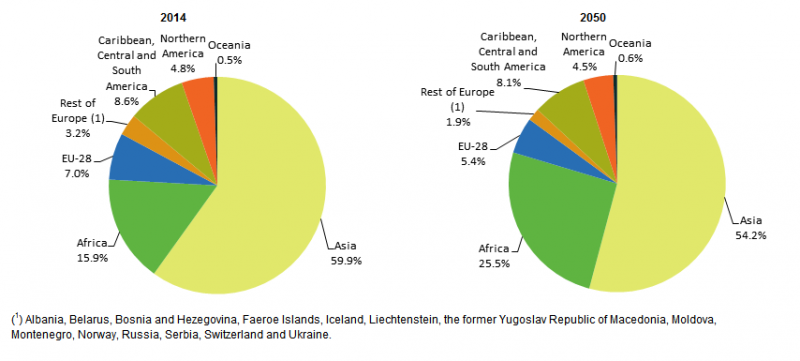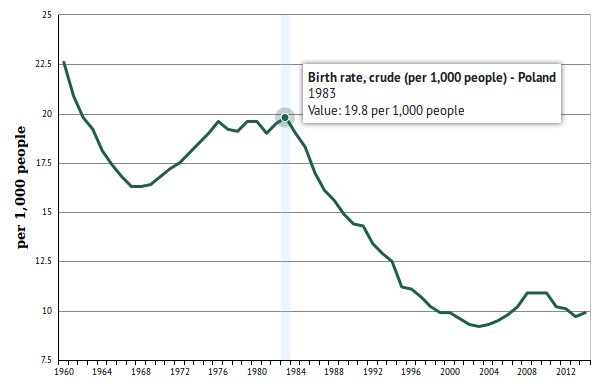How Europe’s demographic winter can be reversed
Dan Roodt discusses the vexed issue of low European birth rates, and how it could be overcome.
Published: December 28, 2016, 5:36 pm
When we gaze into the future, we can see how a lack of children in Germany, Italy, the Czech Republic and many other countries will lead to negative economic consequences as the number of aged dependents simply overwhelm those of working age. The need for young workers is often cited by globalists or immigrationists as an excuse for an open-border policy, such as that of Mrs. Angela Merkel.
Intuitively, one may predict that immigration to Europe will even accelerate the ageing of the population and therefore the current demographic winter. In my view, that will happen because third-world immigrants will occupy the affordable social housing which would otherwise have provided the opportunity for young native couples to have children. This is already happening in the UK, France, Sweden, the Netherlands and other countries where a significant quantity of social housing exists. In a rich country like the Netherlands, 35% of the population lives in some form of social housing, which is rented from public entities.
In at least one study by the London School of Economics, it is admitted that “(e)thnic minorities live disproportionately in social housing, often on large estates – mainly because of poverty, household composition and restricted access to other tenures. The residential pattern of minorities is becoming a political issue in some countries, with concentrations of particular groups being seen as problematic.”
On my visit to Sweden during October this year, I was told that the influx of immigrants and refugees is creating a shortage of housing for native Swedes, as the government was not only providing social housing to newcomers but also renting apartments on the open market on behalf of Middle-Eastern migrants. As someone from a country where housing is relatively affordable, I was simply astounded by the level of Swedish property prices, being the equivalent of about €7 000 per square metre in Stockholm. This is comparable to Paris, where “old” apartments fetch €8 420 per square metre at the moment, as reported by Le Monde. Only Monaco and London with their astronomical property prices cost more.
But it is logical that the influx of migrants into Europe will create shortages in a European housing market that is already extremely expensive by any rational standard. Academic studies done since the 1930s have found a high correlation between European fertility rates and the availability of cheap, affordable housing. In fact, researchers have found that the price of housing is an even better predictor of fertility than the level of income. So solving the problem of European birthrates will be impossible without providing affordable housing to young people of child-bearing age.
According to Housing Europe, a pan-European association of social housing organisations:
“There is a sort of ‘housing trap’ in many EU counties, for people who try to enter the housing market:
- The rental sector is expensive
- Home ownership is not an option due to the even higher cost
- Social homes are just not enough with waiting lists growing in a number of countries, including Italy, the UK, France and Ireland.
This leads in many countries to the generational phenomenon that the majority of people aged 18-34 still live with their parents — 66% of them in Italy, 58% in Portugal, 55% in Spain, 74% in Slovakia etc.”
A dearth of affordable housing in Italy may well be at the heart of that country’s demographic implosion. In 2013 the death rate exceeded the birth rate in Italy, with 8,94 births/1 000 population and 10,01 deaths/1 000 population. If it were not for the high migration rate of 4,47 migrant(s)/1 000 population, the population of Italy would already have been declining.
Alternately put, the population of native Italians is already declining, as these figures confirm. For Italian citizens, the fertility rate is far below the replacement rate of 2,1 per woman, that is, 1,339 children born/woman.
At least one country — the Netherlands — seems to have had positive population growth over the last few decades while providing social housing to its population. From 1980–2009 the population of the Netherlands increased from 14 million to 16,5 million. France also had a surprising jump from 54 million to 64 million in the same period. Obviously, one has to be careful with population statistics as some of these increases could be due to immigration, alternatively to the high fertility rates of immigrant women which would then mask the stagnation or even decline of the native European population. For what it’s worth, here is a graph showing the population growth during the period 1980-2009 in various European countries:
 The phrase borrowed from the French founder of sociology, Auguste Comte, “demography is destiny”, if often cited when population issues are discussed within a political context. American author and conservative pundit, Anne Coulter, has often used it to warn the Republican Party that it was bound to lose its majority-white voter base as immigration from Mexico and other countries would permanently tilt the country in favour of Democratic majorities.
The phrase borrowed from the French founder of sociology, Auguste Comte, “demography is destiny”, if often cited when population issues are discussed within a political context. American author and conservative pundit, Anne Coulter, has often used it to warn the Republican Party that it was bound to lose its majority-white voter base as immigration from Mexico and other countries would permanently tilt the country in favour of Democratic majorities.
Over the last century, Europeans as a percentage of the world population have drastically declined. According to Eurostat, by 2050 there will be roughly five times as many people in Africa as in Europe:
“In 1980, the populations of the EU-28 and Africa were broadly the same… Africa’s population growth has far outstripped that of Europe and projections suggest it will continue to do so. The forecasts predict that Africa will represent 25 % of the world population by 2050, compared to 13 % in 1995 and 16 % in 2014. For the period 2010-2050, Africa is projected to account for over half the growth in world population, while the equivalent figure for the EU-28 is less than 1 %. The result is that the share of EU-28 in the world population should continue its fall from 8 % in 1995, 7 % in 2014 to 5,5 % by 2050.”
In two articles elsewhere, An African Planet? Part I and Part II, I pointed out that while Europe’s population will be declining in absolute terms during the 21st century, that of Africa will quadruple to more than 4 billion, creating an “African Planet”. If nothing else happens, the whole world will resemble South Africa where black people from Africa, but also Muslims, will use their numbers to dominate politically, culturally and economically. Although Africa has so far shown very little competitiveness regarding industry and economic output, Africans are very adept at appropriating the assets and resources of other cultures. Already a far higher portion of so-called development aid is spent on Africa than on any other continent. And when it comes to extravagant consumption, brand awareness and looting the public purse, Africans will give Europeans some lessons.
According to the UN’s demographic projections, by 2100 there will be more people living in a single African country — Nigeria — than in Europe as a whole, including Russia. Nigeria’s population will increase from its current 180 million to more than 900 million.

How Africa’s proportion of the global population will rise, while Europe’s will decline. Source and graph: Eurostat.
On my shelf I have a book bought in the USA, with the ambiguous title: A race against time, signed by the editor, Jared Taylor. That title is still apposite, as Europeans are engaged in a demographic arms race against the rest of the world which they are bound to lose, if nothing else happens! China has discarded its one-child policy and India’s population has risen from 683 million to 1,3 billion since 1980. London, Europe’s financial capital, already has a Muslim mayor, while large parts of the city resemble an outpost of Britain’s populous ex-colony, immortalised in novels such as E.M. Forster’s A passage to India and Paul Scott’s Raj Quartet.
Europeans worldwide who are serious about their future will have to think very hard about the issue of fertility. Just talking about it makes one uncomfortable. After all, having children is a personal choice that no government or even social movement could impose on women. However, I came across this sentence in a recent economic study on the correlation between the housing price and fertility, which puts it in a nutshell:
“(F)ertility is a stochastic outcome, albeit one that is to a large extent controllable by an individual’s actions with regard to sexual activity, contraceptive use, fertility treatments, and abortion.”
I quite like that mathematical phrase “a stochastic outcome”. No-one can predict the future, and very many surprising things are bound to happen. The planet might not be able to carry 11 billion people by 2100 and there might be mass deaths due to famine in Africa or elsewhere; who knows?
On the other hand, the future of the European population and civilisation cannot just be left up to chance. Something has to be done. It is worth debating, or even having conferences about. Think about all the conferences on left-wing topics such as feminism or racism held internationally, but no governmental or international organisation ever discusses the problem of European man’s withering away to the level of extinction.
The current flowering of nationalism among European youth, especially in France, Sweden, Northern Italy and the Visegrad countries (Poland, Czech Republic, Hungary and Slovakia), should be channelled into finding solutions to the housing and employment problems of young Europeans.
Already a large number of Poles (up to one million) live and work in the United Kingdom. After Brexit, their future is probably uncertain, but it shows that many Europeans did take advantage of the EU’s internal open-border policy to seek employment and housing in other countries. While the ideal would be for each European nation to solve its employment and housing problems at home, the current mobility between countries could be used to generate at least temporary income and housing for young Europeans. Cross-border trade in goods and services between European countries is already the norm but perhaps there could be specific solutions to create jobs and housing for young people wanting to start families.
One of the most intriguing things I have recently come across is the so-called Polish baby boom during the period of communist martial law (December 13, 1981 to July 22, 1983) under general Wojciech Jaruzelski. It seems that during the preceding period an atmosphere of hope had been created, persuading people to have children, while curfews and the lack of entertainment during martial law encouraged more intimacy. A resurgence of Catholic values opposing contraception, as well as patriotism, are also given as possible explanations for the baby boom. During and just after the baby boom, communist Poland experienced a shortage of baby clothes and nappies, something which would currently not occur in a capitalist Europe.
As can be seen from the above graph, the Polish birthrate has since declined to the European norm, just under 10 per 1 000 people, with Polish fertility around 1,3 children per woman, far below the replacement level.
Probably, the current Visegrad governments care about the health and the well-being of their peoples, as they (especially Poland and Hungary) are derided by the mainstream media as “right-wing” and opposed to non-European immigration.
My suggestion would be that both existing pro-European governments and the wider patriotic movement throughout the EU start with programmes and investments in housing for young people. As the youth are more mobile, this could also be done in those areas where land is cheap, outside the overpriced and overcrowded main cities. At any rate, given the technological revolution that has taken place over the last twenty years with the advent of the internet, a new architecture and new forms of living and learning together are not only possible, but necessary. Given initiative, proper housing, imaginative planning and execution, some of the economically depressed areas of Europe could become the boomtowns of the future. Here I mean it in the two senses: economically and demographically.
As any economist knows, construction and/or renovation stimulates economic activity, as people moving into a new home need lots of other goods as well, such as furniture, carpets, tiles and even clothes as they may now have more space for hanging them. The benefits of investment in housing for young Europeans could be enormous and could do much to staunch and even reverse demographic decline.
Such investment could be public, or private, or a combination of the two, as already happens in many European countries. Except under socialist governments such social housing is reserved for immigrants, not for locals.
Given the very low or even negative interest rates in the eurozone, but also in the related Scandinavian currencies, investment in housing will be cheap to finance too.
The first step towards overcoming Europe’s demographic winter would have been taken, and could be replicated in other Western countries grappling with similar demographic problems.
All rights reserved. You have permission to quote freely from the articles provided that the source (www.freewestmedia.com) is given. Photos may not be used without our consent.
Consider donating to support our work
Help us to produce more articles like this. FreeWestMedia is depending on donations from our readers to keep going. With your help, we expose the mainstream fake news agenda.
Keep your language polite. Readers from many different countries visit and contribute to Free West Media and we must therefore obey the rules in, for example, Germany. Illegal content will be deleted.
If you have been approved to post comments without preview from FWM, you are responsible for violations of any law. This means that FWM may be forced to cooperate with authorities in a possible crime investigation.
If your comments are subject to preview by FWM, please be patient. We continually review comments but depending on the time of day it can take up to several hours before your comment is reviewed.
We reserve the right to delete comments that are offensive, contain slander or foul language, or are irrelevant to the discussion.

The inflation hoax
Yes, prices are rising, but not for the reasons the Federal Reserve says. When I say inflation is a hoax, I mean the purported cause is a hoax. The Fed is fighting a consumer inflation, a “demand-pull” inflation. But what we are experiencing is a supply-side inflation caused by the Covid lockdowns and economic sanctions that closed businesses, disrupted supply chains, and broke business relationships while reducing energy supplies to the UK and European countries, thus forcing up costs in a globalized economy.

Two-Party Pox: The Republicans suck and the Democrats want to kill you
The Republican Party has never stood up for Americans, will never stand up for them and is not going to do what it takes. Past is prologue.

Russia’s loss at Kharkov highlights crippling shortage of men
KharkovThe frontline in this case relied on heavily outnumbered 2nd rate Lugansk draftees plucked from the LPR.

A country without an honest media is lost
For some time I have reported to you that in place of a media, a media that our founding fathers relied on to protect our society, the United States has had a propaganda ministry whose sole purpose is to destroy our society.

Sweden’s decaying democracy
A journalist is arrested and dragged out of the Gothenburg Book Fair because he politely asked a powerful politician... the wrong questions about his support for the ethnically-cleansed Zimbabwean dictatorship. Not only journalists, but academics and bloggers are being hounded by the leftist establishment daily. And the leftists have all the nasty instruments of the state at their disposal. Citizen reporter Fabian Fjälling looks into their excesses.

The geopolitical future of Nordic countries
Between unity and disunity, independence and foreign interference: Nordic countries have to either choose between creating an independent neutral block in the North, or seeing the region being divided between the great powers.

Russian, Chinese intelligence: ISIS heading for Central Asia with US cover
Operatives of the crumbling Islamic State in Syria and Iraq (ISIS) are moving to new battlegrounds near the Russian border, intelligence sources have revealed.

The unraveling of US/Russian relations
Washington has taken nuclear war against Russia from a hypothetical scenario to a real danger that threatens the future of humanity.

Hero commander killed in Syria – when the war is nearly won
For most Syrians it came as a shock: One of the most popular military commanders of the Syrian Arab Army, Issam Zahreddine, was killed on 18 October 2017.



